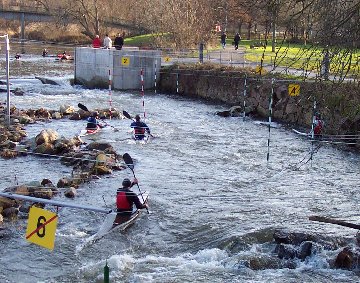Question:

This inner city river channel has to maintain many different boundary conditions to be used as a Kayak Slalom Parcour
- The free-board to maintain flood safety
- The maximum velocity, to reduce erosive forces and to not hinter fauna migration
- The bathymetry (especially the obstacles) are given by the designing landscape architects and shall not be removed, but can be optimized
Difficulty:
Inverse Problem #1:As potentially any points bathymetry value ZF in the model affects the maximum velocity in Zone A (picture) through its bathymetry or roughness.
Inverse Problem #2: As potentially any points bathymetry value ZF in the model affects the threshold criteria: Enough free-board, or not.
[ZF ~ elevation above reference horizon]
Experimental Setup:
This is an academic example to show the usage of adjoints for flood protection and river engineering applications.
64881 Nodes / 12800 cells / 400m long / 40m wide / 4m deep / 0.01 slope/ Run-time 1200s
-> 64881 values affect 2 problems.

Interpretation of the resulting adjoints as a map:
The picture shows the same channel in 3 representations:
- Middle: Field of flow at 50 m³/s. All obstacles are below at least 15cm under the surface.
- Right at the design flood discharge of 400 m³/s: Which points ZF affects the minimum free-board value? The quantification via the adjoint d_Freeboard / d_Bottom (of any point) shows that one obstacle (the red one) has a bigger effect than others.
- Left: Which parts of the bathymetry are responsible at 50cms for the velocity peak in Zone A? Raising red parts would raise the velocity magnitude in Zone A. Raising Blue parts would lower it.
A very interesting insight: Many of the groyne like obstacles have a blue halo. This means that a lowering of the groyne food together with a raise of the head, would raise velocity in Zone A . This is equivalent with a change of the steepness.
Download and experiment with the trail show case:
The example is available for Download as ZIP: -> Link (Registered Users Only!)
If your not already registered: Contact us!:
- The executable is compiled for Ubuntu 64bit.
- Unpack the folder
Executable for Inverse Problem #1:
- Open a Teminal in this folder and execute „./Parcour-Adj-V_zf+ks.exe“
- Results will appear in the file „T2DRES“ in the same folder
Executable for Inverse Problem #2:
- Open a Teminal in this folder and execute „./Parcour-Adj-Freeboard_zf+ks.exe“
- Results will appear in the file „T2DRES“ in the same folder
